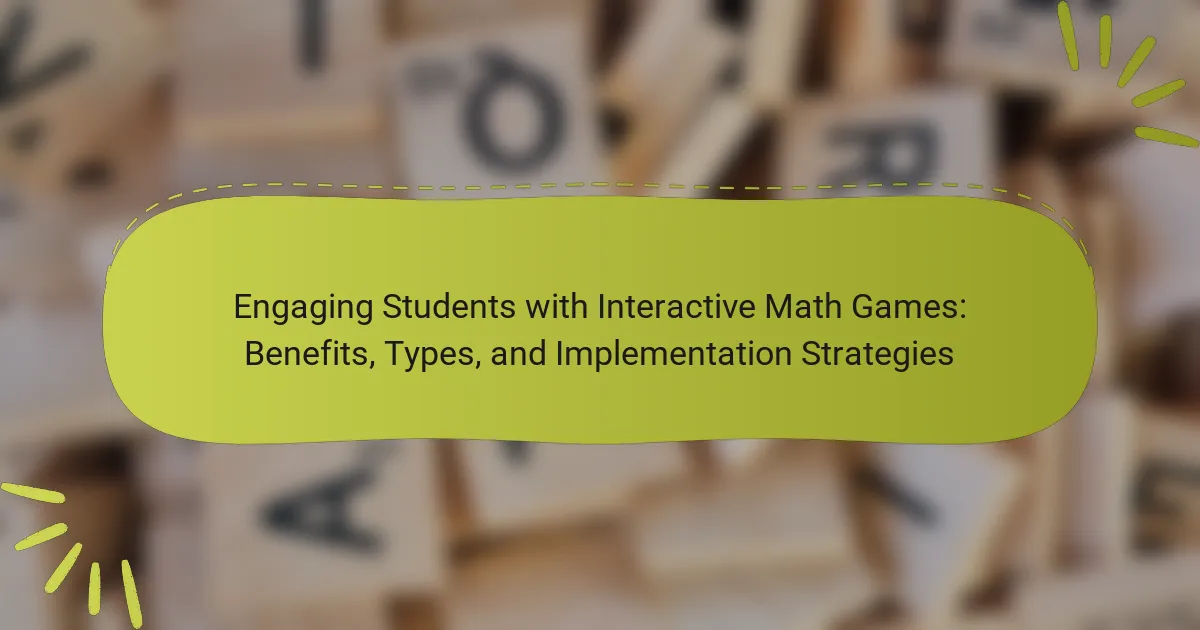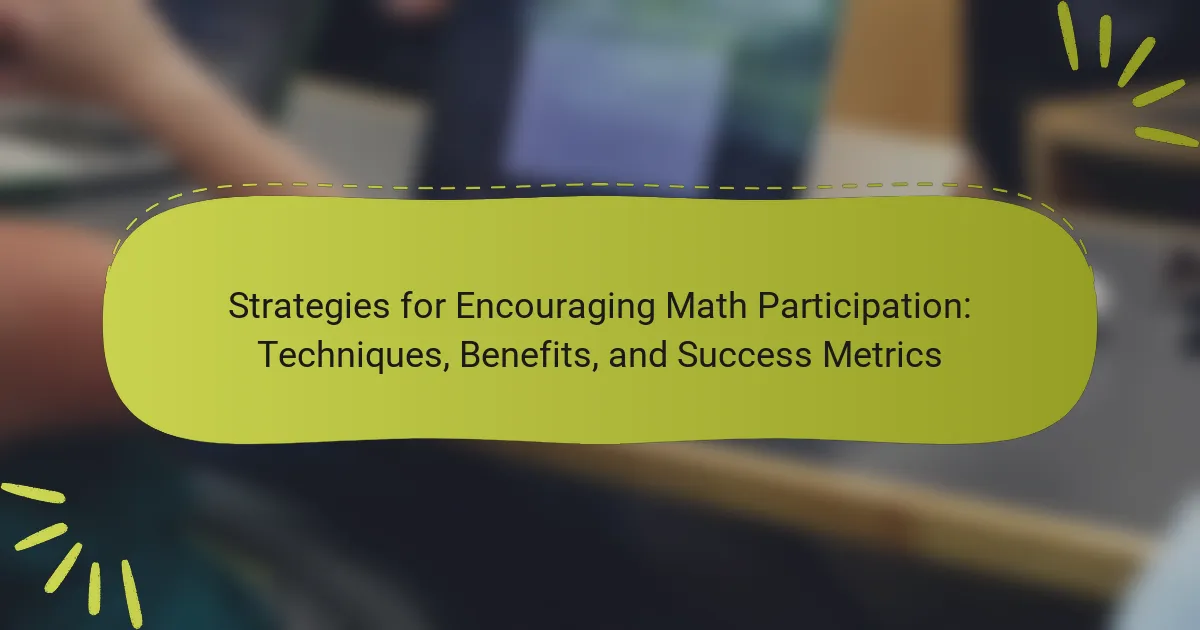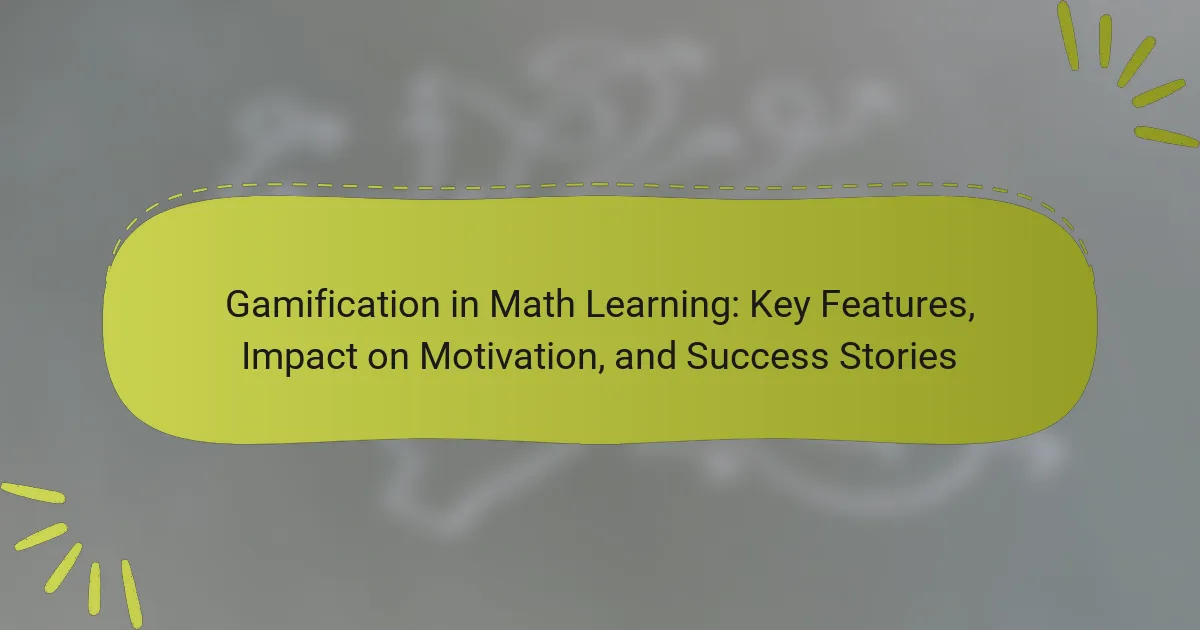Visual aids are essential tools in math education, significantly enhancing students’ understanding, retention, and engagement with mathematical concepts. They provide tangible representations of abstract ideas, facilitating visualization of mathematical relationships and operations. Research indicates that the use of visual aids, including diagrams, charts, and digital simulations, leads to improved problem-solving skills and higher performance on assessments. Additionally, emerging technologies such as augmented reality (AR) and virtual reality (VR) are set to further transform the use of visual aids in classrooms, fostering interactive and personalized learning experiences. Overall, the integration of visual aids in math education supports diverse learning styles and makes math more accessible and enjoyable for all students.
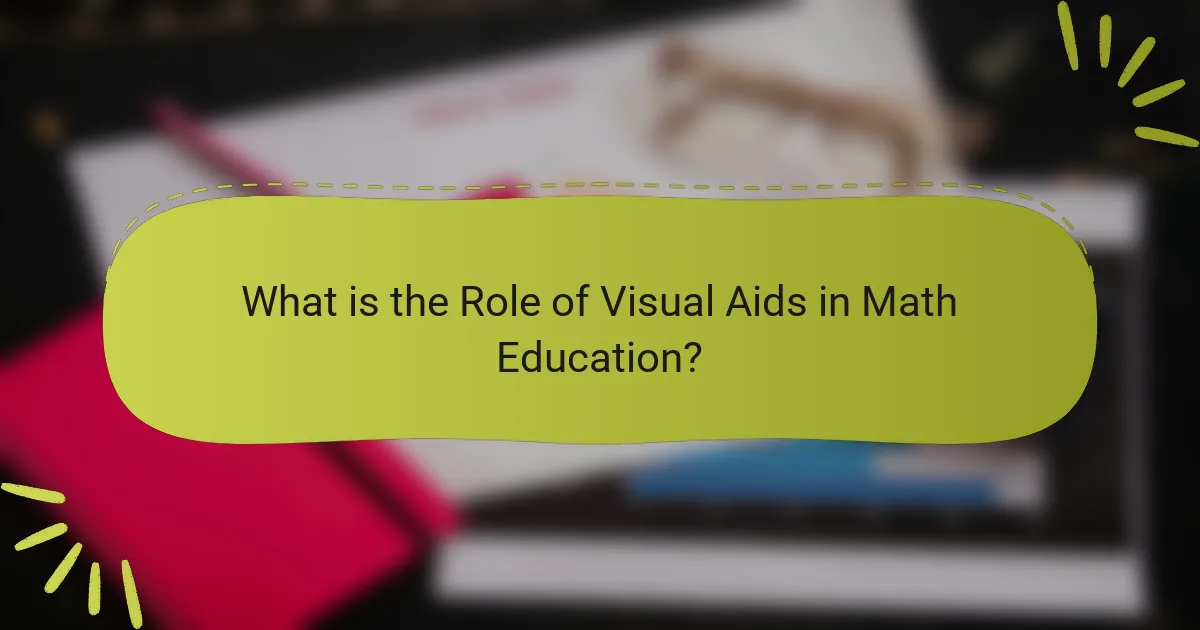
What is the Role of Visual Aids in Math Education?
Visual aids play a crucial role in math education by enhancing understanding and retention of concepts. They provide concrete representations of abstract ideas. This helps students visualize mathematical relationships and operations. Research indicates that students who use visual aids perform better on math assessments. For example, a study by the National Mathematics Advisory Panel found that visual tools improve problem-solving skills. Visual aids also increase student engagement and motivation in learning. By incorporating diagrams, charts, and manipulatives, educators can cater to diverse learning styles. This makes math more accessible and enjoyable for all students.
How do visual aids enhance understanding in math?
Visual aids enhance understanding in math by providing concrete representations of abstract concepts. They help learners visualize relationships between numbers and operations. For example, graphs illustrate functions and data trends clearly. Diagrams can depict geometric shapes and their properties effectively. Charts organize information for easier comprehension. Research shows that students using visual aids perform better on problem-solving tasks. A study by Mayer (2009) highlights that visuals improve retention and recall of mathematical concepts. Visual aids cater to diverse learning styles, making math more accessible. They also stimulate engagement, encouraging active participation in lessons.
What types of visual aids are most effective in teaching math concepts?
Effective visual aids in teaching math concepts include diagrams, charts, manipulatives, and interactive whiteboards. Diagrams help illustrate relationships between mathematical elements. Charts can simplify complex data, making it easier to understand patterns and trends. Manipulatives, such as blocks or tiles, provide hands-on experience for grasping abstract concepts. Interactive whiteboards enhance engagement through interactive lessons. Research shows that using these aids can improve student comprehension and retention. A study by the National Mathematics Advisory Panel found that visual representations significantly support learning in mathematics.
How do visual aids cater to different learning styles in math education?
Visual aids cater to different learning styles in math education by providing diverse methods of information representation. Visual learners benefit from diagrams and charts that illustrate concepts. Auditory learners may engage better with visual aids that include verbal explanations or annotations. Kinesthetic learners can use manipulatives alongside visual aids to enhance tactile experiences. Research shows that students retain information better when concepts are presented visually. A study by Mayer (2005) indicates that multimedia presentations improve understanding across various learning styles. Overall, visual aids support differentiated instruction, making math accessible to all learners.
Why are visual aids important for retention in math learning?
Visual aids are important for retention in math learning because they enhance understanding and memory. They provide concrete representations of abstract concepts. This visual representation helps students grasp complex ideas more easily. Studies show that learners retain information better when it is presented visually. For instance, a study by Mayer (2009) indicates that students using visual aids outperform those relying solely on text. Visual aids also engage multiple senses, which can improve cognitive processing. They facilitate connections between prior knowledge and new information. Overall, visual aids make math concepts more accessible and memorable for students.
What research supports the use of visual aids for memory retention in math?
Research indicates that visual aids significantly enhance memory retention in math. A study by Mayer (2005) found that students who used visual aids performed better on math retention tests. Another research by Hegarty and Kozhevnikov (2009) showed that visual representations help in understanding complex mathematical concepts. These findings suggest that incorporating visual aids can effectively improve students’ ability to remember mathematical information.
How do visual aids help in recalling mathematical concepts during assessments?
Visual aids significantly enhance the recall of mathematical concepts during assessments. They provide a visual representation of abstract ideas, making them more tangible. This aids in understanding complex relationships and processes. Research shows that visual aids can improve memory retention by up to 65%. Diagrams, graphs, and charts help students visualize problems, leading to quicker problem-solving. They also reduce cognitive load by simplifying information. This allows students to focus on essential concepts rather than being overwhelmed by text. Overall, visual aids are crucial tools for effective learning and assessment in mathematics.
In what ways do visual aids increase engagement in math classes?
Visual aids increase engagement in math classes by providing clear representations of abstract concepts. They help students visualize relationships between numbers and shapes. This visualization makes complex ideas more accessible. Studies show that students who use visual aids perform better in problem-solving tasks. For example, a study published in the Journal of Educational Psychology found that students using diagrams scored 20% higher on assessments. Visual aids also stimulate discussion among students. They encourage collaboration and peer-to-peer learning. Engaging with visual aids can lead to increased motivation and interest in math. Overall, these tools create a more interactive learning environment.
What role do interactive visual aids play in student participation?
Interactive visual aids significantly enhance student participation in educational settings. They engage students by making learning more dynamic and interactive. These aids facilitate better understanding of complex concepts through visual representation. Research shows that students retain information better when it is presented visually. For instance, a study by Mayer and Moreno (2003) found that multimedia presentations increase student engagement and participation. Additionally, interactive elements encourage collaboration among students. This collaboration fosters a deeper understanding of the material being taught. Overall, interactive visual aids play a crucial role in promoting active participation in learning environments.
How can teachers effectively incorporate visual aids into their math lessons?
Teachers can effectively incorporate visual aids into their math lessons by using charts, diagrams, and interactive tools. Visual aids help clarify complex concepts. For instance, a pie chart can illustrate fractions. Diagrams can simplify geometric shapes. Interactive tools like digital whiteboards engage students actively. Research shows that visual aids enhance retention by 65%. This statistic highlights their importance in learning. Teachers should select visuals that align with lesson goals. Tailoring aids to student needs increases understanding. Regular use of visuals can foster a more engaging learning environment.
What challenges do educators face when using visual aids in math education?
Educators face several challenges when using visual aids in math education. One significant challenge is ensuring that visual aids are effectively aligned with the curriculum. Misalignment can lead to confusion among students. Another challenge is the varying levels of student engagement. Some students may find visual aids helpful, while others may not respond positively. Additionally, educators often struggle with the integration of technology. Technical issues can disrupt lessons and hinder the learning experience. Furthermore, there is a risk of oversimplification. Simplified visuals may omit critical details, leading to misunderstandings. Lastly, educators may lack training in effectively using visual aids. This can limit their ability to maximize the benefits of these tools.
How can teachers overcome these challenges to maximize the benefits of visual aids?
Teachers can overcome challenges with visual aids by integrating them effectively into lessons. They should align visual aids with learning objectives. This ensures that visuals support the content being taught. Teachers can also provide clear explanations of the visuals used. This helps students understand their relevance and application. Additionally, teachers should encourage student interaction with visual aids. Engaging students actively enhances comprehension and retention. Regular feedback on the use of visual aids can help refine their effectiveness. Studies show that well-integrated visual aids improve learning outcomes significantly. For example, research by Mayer (2009) indicates that multimedia instruction enhances understanding in math education.
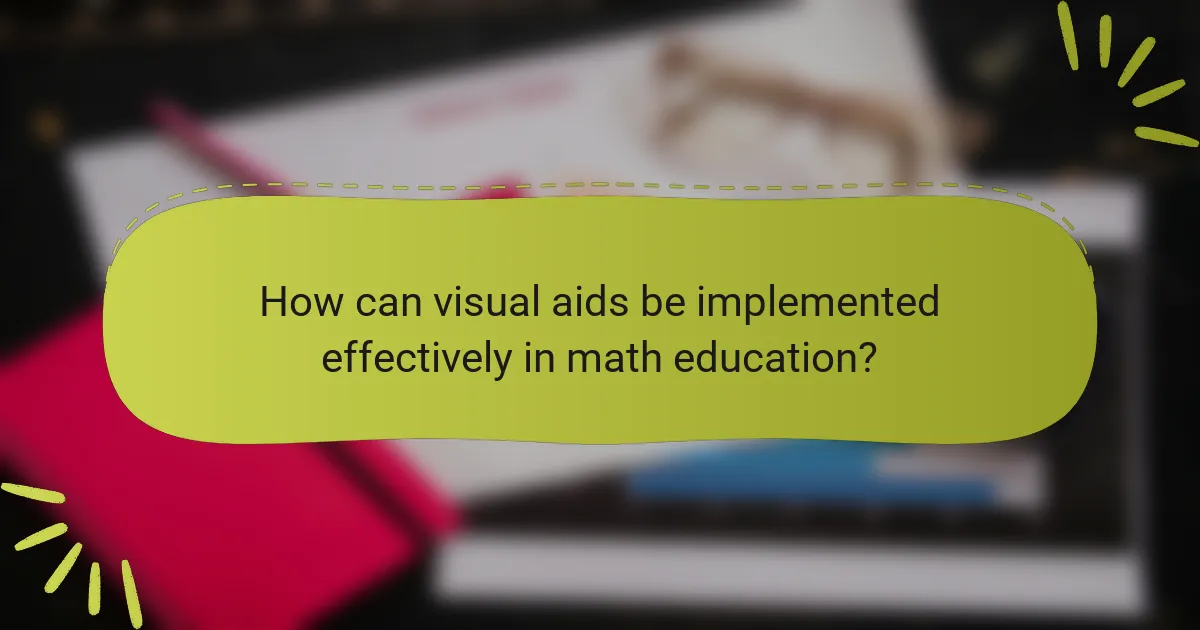
How can visual aids be implemented effectively in math education?
Visual aids can be implemented effectively in math education by integrating them into lesson plans. Teachers should use diagrams, charts, and models to illustrate mathematical concepts. These tools help students visualize abstract ideas. Interactive visual aids, such as digital simulations, can enhance engagement. Incorporating visual aids during problem-solving encourages active participation. Research shows that students retain information better when visual aids are used. For example, studies indicate that students using visual representations scored higher on assessments. This demonstrates the effectiveness of visual aids in improving understanding and retention in math education.
What are the best practices for selecting visual aids in math teaching?
The best practices for selecting visual aids in math teaching include aligning aids with learning objectives. Visual aids should enhance understanding of mathematical concepts. They must be age-appropriate and relevant to the curriculum. Clear and simple designs improve student focus and comprehension. Interactive elements can engage students and encourage participation. Teachers should consider the diverse learning styles of students. Incorporating real-world examples can make math more relatable. Regularly assessing the effectiveness of visual aids is essential for continuous improvement.
How can teachers assess the effectiveness of visual aids in their lessons?
Teachers can assess the effectiveness of visual aids by observing student engagement and comprehension. They can measure engagement through student participation and attentiveness during lessons. Comprehension can be evaluated through quizzes or discussions after the use of visual aids. Teachers can also gather feedback from students about their understanding of the material presented visually. Additionally, comparing test scores before and after the introduction of visual aids provides quantitative data on their effectiveness. Research shows that visual aids enhance retention and understanding, supporting their use in math education. A study by Mayer (2009) indicates that multimedia presentations improve learning outcomes significantly.
What resources are available for educators to find quality visual aids?
Educators can find quality visual aids through various resources. Online platforms like Teachers Pay Teachers offer downloadable resources created by other educators. Websites such as Canva provide customizable templates for visual aids. Educational publishers often have resource sections with visual aids related to their textbooks. Additionally, sites like Pinterest feature a wealth of visual teaching ideas shared by educators. Google Images can also be a useful tool for finding specific visual aids. Many educational organizations provide free resources on their websites. These resources help enhance understanding and engagement in math education.
How can technology enhance the use of visual aids in math education?
Technology enhances the use of visual aids in math education by providing interactive tools that engage students. Digital platforms allow for dynamic visualizations of mathematical concepts. Software can create graphs, charts, and animations that illustrate complex ideas. This interactivity fosters deeper understanding and retention of information. For example, tools like GeoGebra enable students to manipulate variables in real-time. Research shows that students using technology-based visual aids perform better in problem-solving tasks. A study by the National Mathematics Advisory Panel found that visual representations improve learning outcomes. Thus, technology significantly amplifies the effectiveness of visual aids in math education.
What digital tools can teachers use to create or find visual aids?
Teachers can use various digital tools to create or find visual aids. Tools like Canva allow for customizable graphic designs. Google Slides facilitates the creation of presentations with visual elements. Prezi offers dynamic presentation options that engage students. Piktochart specializes in infographics that simplify complex data. Microsoft PowerPoint is widely used for creating slideshows with visuals. Adobe Spark provides templates for creating videos and graphics. Teachers can also access educational resources on platforms like Teachers Pay Teachers. These tools enhance visual learning and engagement in math education.
How does the integration of technology change the dynamics of visual aid usage?
The integration of technology transforms the dynamics of visual aid usage by enhancing interactivity and accessibility. Digital tools allow for real-time manipulation of visual aids, making them more engaging. Students can interact with graphs, diagrams, and simulations directly. This interaction promotes deeper understanding of mathematical concepts. Technology also enables personalized learning experiences. For instance, adaptive software tailors visual aids to individual learning needs. Research shows that students using interactive visual aids score higher in math assessments. A study by the University of California found that technology-enhanced visual aids improved student retention rates by 30%. Overall, technology significantly enriches the effectiveness of visual aids in education.
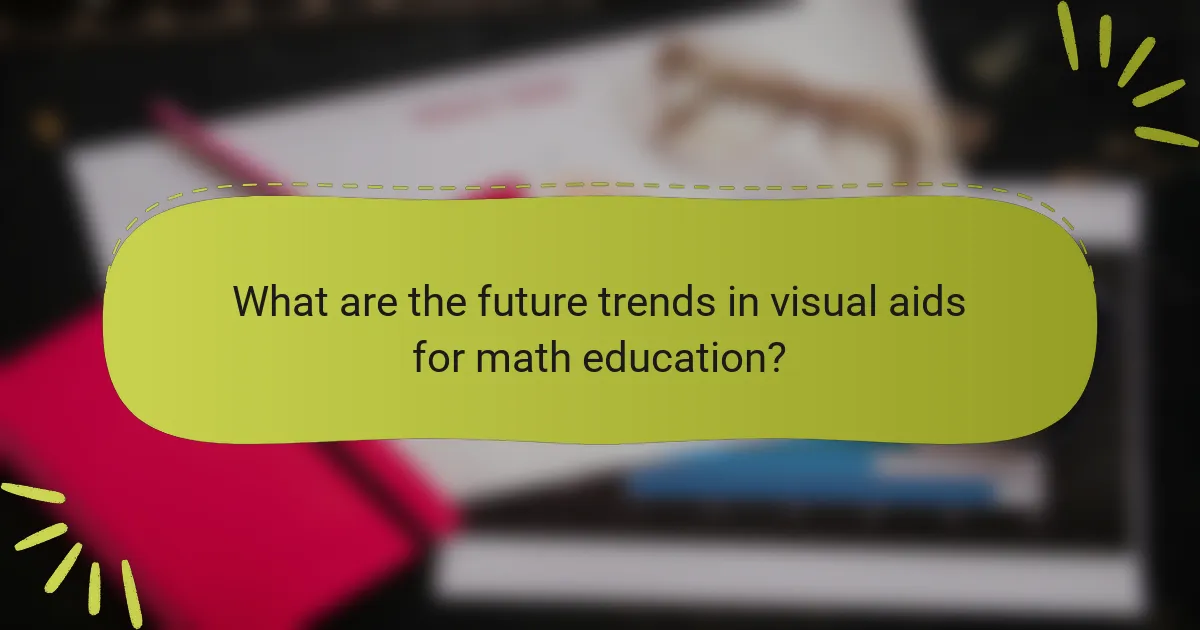
What are the future trends in visual aids for math education?
Future trends in visual aids for math education include the integration of augmented reality (AR) and virtual reality (VR) technologies. These technologies create immersive learning experiences, enhancing student engagement and understanding. Research shows that AR can improve spatial reasoning skills, which are crucial in math. Additionally, interactive digital platforms are on the rise. They allow for real-time feedback and personalized learning experiences. Data from educational studies indicate that students using these platforms show improved retention rates. Furthermore, the use of gamification in visual aids is becoming more prevalent. This approach motivates students through game-like elements, making learning more enjoyable. Overall, these trends indicate a shift towards more interactive and engaging visual aids in math education.
How is the use of augmented reality shaping visual aids in math learning?
The use of augmented reality (AR) is transforming visual aids in math learning. AR provides immersive experiences that enhance student engagement. It allows learners to visualize complex mathematical concepts in a three-dimensional space. For instance, students can interact with geometric shapes and equations in real-time. This interaction improves comprehension and retention of mathematical principles. Research indicates that students using AR tools show higher test scores compared to traditional methods. A study by Billinghurst and Dunser (2012) highlights AR’s effectiveness in education. It emphasizes that AR can bridge the gap between abstract concepts and tangible understanding.
What potential does virtual reality hold for immersive math education?
Virtual reality (VR) holds significant potential for immersive math education. It can create interactive environments where students visualize complex mathematical concepts. For instance, VR can transform abstract ideas, like geometry, into 3D models that students can manipulate. This hands-on approach enhances understanding and retention. Research shows that immersive experiences improve engagement levels in learning. A study by Mikropoulos and Natsis (2011) found that students using VR achieved better learning outcomes in geometry than traditional methods. VR also caters to various learning styles, making math more accessible. Overall, VR can revolutionize math education by making it more engaging and effective.
How can educators prepare for the evolving landscape of visual aids in math?
Educators can prepare for the evolving landscape of visual aids in math by integrating technology into their teaching methods. This includes utilizing interactive software and applications that enhance visual learning. Research shows that students engage better with dynamic visual aids compared to static images. For instance, studies indicate that interactive simulations can increase student understanding of complex mathematical concepts by up to 30%. Additionally, educators should stay updated on emerging tools and resources that support visual learning. Attending workshops and training sessions focused on visual aids can further enhance their skills. Collaborating with colleagues to share best practices also fosters a supportive learning environment. By adopting these strategies, educators can effectively adapt to changes in visual aids and improve student outcomes.
What practical tips can teachers follow to enhance their use of visual aids in math?
Teachers can enhance their use of visual aids in math by integrating various techniques. First, they should align visual aids with learning objectives. This ensures that the aids support specific concepts. Second, teachers can utilize a mix of visual formats. Charts, graphs, and interactive tools can cater to diverse learning styles. Third, they should encourage student interaction with visual aids. This promotes engagement and deeper understanding. Fourth, teachers can incorporate real-world examples in visual aids. This contextualizes math concepts and makes them relatable. Fifth, they should regularly assess the effectiveness of visual aids. Feedback helps in refining their use. Finally, teachers can collaborate with colleagues to share effective visual strategies. This fosters a community of practice focused on enhancing math education.
The main entity of the article is visual aids in math education. The article outlines the critical role visual aids play in enhancing students’ understanding, retention, and engagement with mathematical concepts. It discusses various types of effective visual aids, including diagrams, charts, and manipulatives, and how they cater to different learning styles. Additionally, the article highlights the importance of integrating technology, such as augmented and virtual reality, to create immersive learning experiences. Research findings supporting the efficacy of visual aids in improving problem-solving skills and academic performance are also presented.
